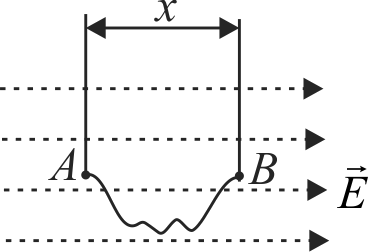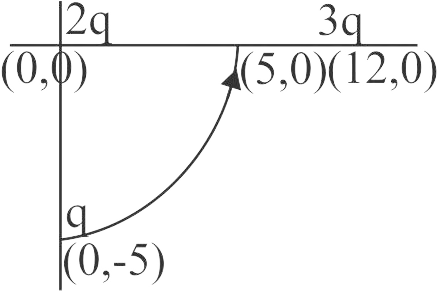359483
A uniform electric field vector \(\vec{E}\) exists along horizontal direction as shown. The electric potential at \(A\) is \(V_{A}\). A small point charge \(q\) is slowly taken from \(A\) to \(B\) along the curved path as shown: The potential energy of the charge when it is at point \(B\) is
359486
2\(q\) and 3\(q\) are two charges separated by a distance 12 \(cm\) on \(x\)- axis.A third charge \(q\) is placed at 5 \(cm\) on \(y\) -axis as shown in the figure. Find the change in potential energy of the system if \(q\) is moved from initial position to a point on \(X\) - axis in circular path:
359483
A uniform electric field vector \(\vec{E}\) exists along horizontal direction as shown. The electric potential at \(A\) is \(V_{A}\). A small point charge \(q\) is slowly taken from \(A\) to \(B\) along the curved path as shown: The potential energy of the charge when it is at point \(B\) is
359486
2\(q\) and 3\(q\) are two charges separated by a distance 12 \(cm\) on \(x\)- axis.A third charge \(q\) is placed at 5 \(cm\) on \(y\) -axis as shown in the figure. Find the change in potential energy of the system if \(q\) is moved from initial position to a point on \(X\) - axis in circular path:
359483
A uniform electric field vector \(\vec{E}\) exists along horizontal direction as shown. The electric potential at \(A\) is \(V_{A}\). A small point charge \(q\) is slowly taken from \(A\) to \(B\) along the curved path as shown: The potential energy of the charge when it is at point \(B\) is
359486
2\(q\) and 3\(q\) are two charges separated by a distance 12 \(cm\) on \(x\)- axis.A third charge \(q\) is placed at 5 \(cm\) on \(y\) -axis as shown in the figure. Find the change in potential energy of the system if \(q\) is moved from initial position to a point on \(X\) - axis in circular path:
359483
A uniform electric field vector \(\vec{E}\) exists along horizontal direction as shown. The electric potential at \(A\) is \(V_{A}\). A small point charge \(q\) is slowly taken from \(A\) to \(B\) along the curved path as shown: The potential energy of the charge when it is at point \(B\) is
359486
2\(q\) and 3\(q\) are two charges separated by a distance 12 \(cm\) on \(x\)- axis.A third charge \(q\) is placed at 5 \(cm\) on \(y\) -axis as shown in the figure. Find the change in potential energy of the system if \(q\) is moved from initial position to a point on \(X\) - axis in circular path:
359483
A uniform electric field vector \(\vec{E}\) exists along horizontal direction as shown. The electric potential at \(A\) is \(V_{A}\). A small point charge \(q\) is slowly taken from \(A\) to \(B\) along the curved path as shown: The potential energy of the charge when it is at point \(B\) is
359486
2\(q\) and 3\(q\) are two charges separated by a distance 12 \(cm\) on \(x\)- axis.A third charge \(q\) is placed at 5 \(cm\) on \(y\) -axis as shown in the figure. Find the change in potential energy of the system if \(q\) is moved from initial position to a point on \(X\) - axis in circular path: